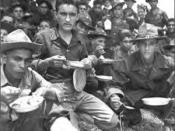� PAGE \* MERGEFORMAT �1� Hispanic American Diversity
Hispanic Groups in the United States
Sandra Swartzwelder
ETH/125
May 30, 2010
Dan Semrau
Mexican, Puerto Rican, Cuban, and Costa Rican Americans have a lot in common, yet are different in many ways. This paper will identify the linguistic, political, social, economic, religious, and familial statuses of the above stated groups. The United States is where most tend to immigrate to in order to achieve the American Dream, as well as asylum. As the immigration rates of different ethnic groups continues to rise, Americans are becoming more accepting than in previous years.
Mexican Americans
While many Mexican Americans immigrated to the United States to attain the American Dream, there were many obstacles that would be barriers in achieving that goal. Language was and is a major barrier. English is the common language in the United States, and most Mexican Americans spoke Spanish.
Those that did not speak English, were excluded from employment opportunities and other endeavors because of the language barrier. As the years have passed, Mexican Americans have adapted to speaking English, as well as Spanish. Mexican Americans is the largest of the Hispanic Groups in the United States, giving them the potential to be very powerful on the voting bloc, but there are many factors that get in the way of their political participation, such as age, citizenship, distrust of politics, and the feeling that their vote will not matter. Economic and social opportunities are few for Mexican Americans. Mexicans are considered an immigrant group seeking low wage employment to better themselves, with a low rate of self employment and entrepreneurships (Alba, 2006). Religion plays an important role in the lives of many Mexican Americans. Most are Roman Catholics, but some do choose other religions. Family also plays an important...



:D
love it
1 out of 1 people found this comment useful.